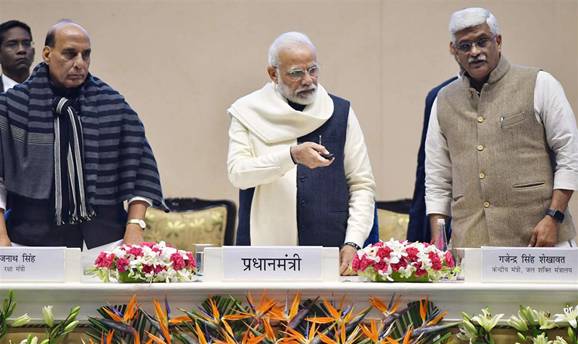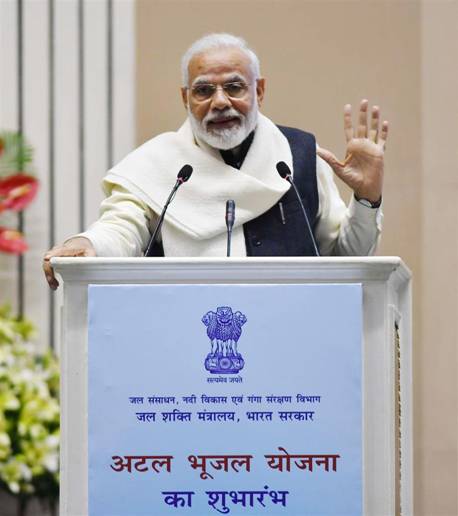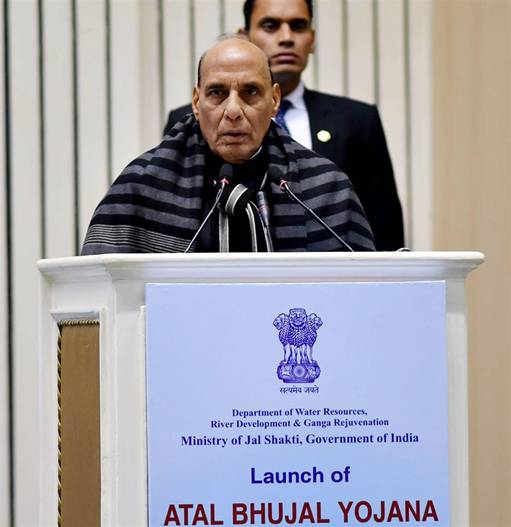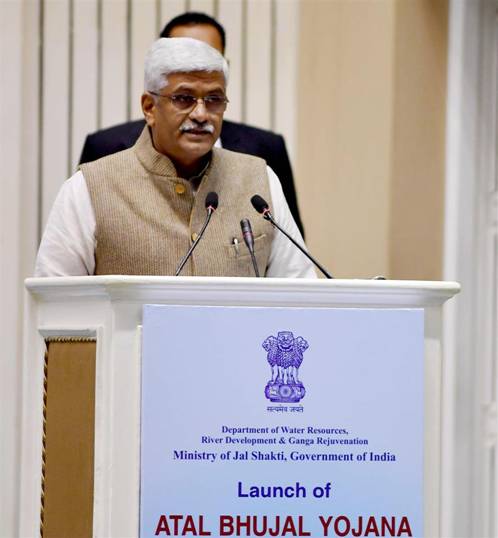Ministry of Jal Shakti
Prime Minister Launches Atal Bhujal Yojana
Strategic Tunnel under Rohtang Pass named after former Prime Minister Atal Bihari Vajpayee
Drinking water through taps will be provided to every household: Shri Gajendra Singh Shekhawat
Atal Bhujal Yojana will be implemented through Jal Jeevan Mission (JJM) in 8350 villages in seven States
प्रविष्टि तिथि:
25 DEC 2019 2:53PM by PIB Delhi
On the Birth anniversary of former Prime Minister Atal Bihari Vajpayee, Prime Minister Shri Narendra Modi launched Atal Bhujal Yojana (ATAL JAL) and named the Strategic Tunnel under Rohtang Pass after Vajpayee, in an event held in New Delhi today.

Speaking on the occasion, Prime Minister said that today the name of a big project which is very important for the country, Rohtang Tunnel, connecting Manali, Himachal Pradesh with Leh, Ladakh and Jammu Kashmir, will now be known as Atal Tunnel. He also said that this strategic tunnel will change the fortunes of this region. It will help in promoting tourism in the region.
On Atal Jal Yojana, PM highlighted that the subject of water was very important to Atal ji and very close to his heart. Our Government is striving to implement his vision. Atal Jal Yojana or the guidelines related to the Jal Jeevan Mission, are big steps in proving the resolve to deliver water to every household in the country by 2024, the PM added. He said that this water crisis is worrying for us as a family, as a citizen and as a country also it affects development. New India has to prepare us to deal with every situation of water crisis. For this, we are working together on five levels.

Prime Minister emphasized that Jal Shakti Ministry freed the water out of Compartmentalized Approach and laid stress on a Comprehensive and Holistic Approach. In this monsoon, we have seen how extensive efforts have been made for water conservation on behalf of the society, from the Jal Shakti Ministry. He said that on one hand, Jal Jeevan Mission, will work towards delivering piped water supply to every house, and on the other hand Atal Jal Yojana, will pay special attention to those areas where groundwater is very low.
To incentivise gram panchayats to perform better in water management, Prime Minister said that a provision has been made in the Atal Jal Yojana, in which better performing gram panchayats, will be given more allocation. He said that in 70 years, only 3 crore out of 18 crore rural households have access to piped water supply. Now our Government has set the target to deliver clean drinking water to 15 crore homes in the next five years through pipes.
Prime Minister emphasized that water-related schemes should be made according to the situation at every village level. This has been taken care while making the guidelines of the Jal Jeevan Mission, he added. He also said that both Union and State Governments will spend Rs 3.5 lakh crore on water related schemes in the next 5 yrs. He requested the people of every village to make a water action plan and create a water fund. Farmers should make a water budget where groundwater is very low.
Speaking on the occasion, the Union Defence Minister, Shri Rajnath Singh said that our economy is dependent on water conservation and we have to be carefully using water resources. We need to take concerted efforts to increase the ground water level. Shri Singh complemented the Prime Minister for naming the Rohtang tunnel after the former PM Shri Atal Bihari Vajpayee as ‘Atal tunnel’.

The Union Minister for Jal Shakti, Shri Gajendra Singh Shekhawat while addressing the gathering said that under Atal Bhujal Yojana, government is committed to provide safe drinking water to every household in the country. He further said that largely we are dependent on ground water and it is fulfilling 85% of drinking water requirements in the country. There is every need to take steps to increase the ground water level, he added.

The Minister of State for Jal Shakti, Social Justice & Empowerment, Shri Rattan Lal Kataria and other dignitaries were present on the occasion.
Atal Bhujal Yojana (ATAL JAL)
ATAL JAL has been designed with the principal objective of strengthening the institutional framework for participatory groundwater management and bringing about behavioral changes at the community level for sustainable groundwater resource management in seven States, viz. Gujarat, Haryana, Karnataka, Madhya Pradesh, Maharashtra, Rajasthan and Uttar Pradesh. Implementation of the scheme is expected to benefit nearly 8350 Gram Panchayats in 78 districts in these States. ATAL JAL will promote panchayat led ground water management and behavioural change with primary focus on demand side management
Out of the total outlay of Rs. 6000 crore to be implemented over a period of 5 years (2020-21 to 2024-25), 50% shall be in the form of World Bank loan, and be repaid by the Central Government. The remaining 50% shall be through Central Assistance from regular budgetary support. The entire World Bank's loan component and Central Assistance shall be passed on to the States as Grants.
Tunnel under Rohtang Pass
The historic decision to construct a strategic tunnel below the Rohtang Pass was taken by former Prime Minister Atal Bihari Vajpayee. The 8.8-kilometre long tunnel is the world's longest tunnel above an altitude of 3,000 metres. It will reduce the distance between Manali and Leh by 46 kilometres and save crores of rupees in transport costs. It is a 10.5-metre wide single tube bi-lane tunnel with a fire proof emergency tunnel built into the main tunnel itself. The breakthrough from both ends was achieved on October 15, 2017. The tunnel is now nearing completion and is a step in the direction of providing all weather connectivity to remote border areas of Himachal Pradesh and Ladakh which otherwise remained cut off from the rest of the country for about six months during winters.
Following are the Operational Guidelines:
- The Union Cabinet on 13.08.2019 approved Jal Jeevan Mission (JJM) to provide Functional Household Tap Connection (FHTC) to every rural household by 2024.
- As per the information available, out of 17.87 Crore rural households in the country, about 14.6 Crore which accounts for 81.67% are yet to have household water tap connections. The total project cost is estimated to be about Rs 3.60 lakh Crore. Central share will be Rs.2.08 lakh Crore. The fund sharing pattern to be 90:10 for Himalayan and North-Eastern States; 50:50 for other States and 100% for UTs.
- Broad contours of the JJM was circulated to all the States/UTsgiving details of the Mission and expected actions from States/ UTs. A National Level State Ministers’ conference chaired by the Minister of Jal Shakti was held on 26/8/2019, wherein modalities of implementation of JJM were discussed at length.
- As decided by the Government, five regional workshops were organized one each in north, east, west, south and north-eastern regions of the country, wherein all stakeholders in water supply like, State Governments, voluntary organizations, development partners, professionals in water sector, etc. participated.
- Further, the Department has carried out review of questions raised by Hon’ble MPs in Parliament, for developing a broad understanding of issues in drinking water supply sector as are being faced in different parts of the country with the purpose that, while formulating guidelines, strategy and implementation aspects to the issues at hand get addressed to the extent possible. Similarly, Standing Committee reports andAudit reports were examined in detail to get an overview of the shortcomings in the implementation of NRDWP so as to address the observations in the guidelines.
- Consultations were also held on implementation aspects of the Mission with other Ministries of Government of India.
- Considering above aspects, Operational Guidelines of Jal Jeevan Mission has been finalized. The Operational Guidelineswas also put up on the portal of Ministry of Jal Shakti, Department of Drinking Water and Sanitation for feedback/ comments from The salient features of the guidelines are as follows:
i.) Time bound completion of schemes taken up under National Rural Drinking Water Programme (NRDWP) has been proposed by providing FHTC to every rural household. No extension of time or cost escalation will be allowed except for the cost towards retrofitting the same to provide FHTCs.
ii.) Priority to cover water quality affected habitations under JJM will be given.
iii.) For the implementation of JJM, following institutional arrangement has been proposed:
(a.) National Jal Jeevan Mission at the Central level;
(b.) State Water and Sanitation Mission (SWSM) at State level;
(c.) District Water and Sanitation Mission (DWSM) at district level; and
(d.) Gram Panchayat and/ or its sub-committees i.e.Village Water Sanitation Committee(VWSC)/ Paani Samiti at village Level.
iv.) Extra budgetary resources will be made available for JJM and is proposed to be allocated along with Gross Budgetary Support among States/ UTs as per the allocation criteria.
v.) Good performance of the States/ UTs will be incentivized out of the fund not utilized by other States at the fag end of the financial year.
vi.) The fund released by Central Government to the State Governments is to be deposited in one Single Nodal Account (SNA) that will be maintained by SWSM along with State matching share to be transferred within 15 days of Central release. Public Finance Management System (PFMS) should be used for tracking the funds.
vii.) The physical and financial progress of the mission is proposed to be monitored through IMIS and fund utilization through PFMS.
viii.) No expenditure towards centage charges, O&M cost of the schemes like electricity charges, salary of regular staff and purchase of land, etc. will be allowed out of Central share.
ix.) Imbibing the spirit of 73rd Amendment of Constitution of India, Gram Panchayats or its sub-committees will play a crucial role in planning, designing, execution, operations and maintenance of the in-village infrastructure.
x.) To bring in sense of ownership and pride among rural communities, 5% capital cost contribution towards in-village water supply infrastructure in hilly, forested, and more than 50% SC/ ST dominant population villages, and 10% in the remaining villages is proposed.
xi.) Communities to be rewarded by providing 10% of the in-village infrastructure cost of the scheme which will be maintained by them as a revolving fund to meet any unforeseen expenditure due to break down, etc.
xii.) To handhold and facilitate the implementation of in-village infrastructure and community participation process, Gram Panchayat and/ or its sub-committee, Implementation Support Agencies (ISAs), viz. Self-Help Groups (SHGs)/ CBOs/ NGOs/ VOs, etc. is proposed to be identified and empanelled by state government and engaged by SWSM/ DWSM as per the requirement.
xiii.) In order to ensure faster implementation with ‘speed and scale’ in a time-bound manner for providing FHTC in every rural household by 2024, it is proposed to forge partnership with all stakeholders in water sector namely; voluntary organizations, sector partners, professionals in water sector, foundations and CSR arms of various corporates.
xiv.) JJM aims at providing potable water in adequate quantity i.e. 55 litre per capita per day (lpcd) of prescribed quality i.e. BIS Standard of IS: 10500 on regular basis. Assured availability of safe drinking water in the household premises will improve the health and thereby socio-economic condition of the rural population and will also bring down the drudgery of rural women, especially girls.
xv.) Every village is to prepare a village action plan (VAP) which will be essentially having three components namely; i.) water source & its maintenance ii.) water supply and iii.) grey water management. Village action plan will be aggregated at district level to formulate the District action plan which will be aggregated at State level to formulate the State action plan. State action plan will give a holistic view especially covering projects like regional grids, bulk water supply and distribution projects to address the needs of water stressed areas and will also have a plan for ensuring drinking water security in the State.
xvi.) SWSM will decide rate contracts and empanel reputed construction agencies/ vendors through centralized tendering and also to prepare design templates for expeditious implementation.
xvii.) Mandatory source sustainability measures like rain water harvesting, groundwater recharge and other water conservation measures as along with grey water management (including reuse) are proposed to be undertaken in convergence with MGNREGS and grants under Finance Commission, State Finance Commission, District Mineral Development Fund (DMF), etc. It has been proposed to assess and pool the fund available for drinking water supply from various sources be it, Government such as MPLADS, MLALADS, DMDF or donations whether at State level or village level be strictly utilized as per the approved plans. This helps in preventing creation of parallel water supply infrastructure deviating from the approved plan.
xviii.) The guidelines also propose that States will have a definite O&M policy especially to meet with the O&M requirements like monthly energy cost of the PWS scheme, by ensuring cost recovery from user groups and thereby avoiding any unwanted burden on public exchequer.
xix.)JJM envisages a structural change in the provision of drinking water supply services. The service provision should change to ‘utility based approach’ centered on ‘service delivery’. Such a reform is proposed in the guidelines so as to enable the institutions to function as utilities focusing on services and recover water tariff/ user fee.
xx.) Measuring water to ascertain the availability and the quality using sensors based IoT technologies is also proposed in the guidelines.
xxi.) Third party inspection is proposed to be undertaken before making any payment to instill accountability.
xxii.) Functionality assessment of the schemes implemented under JJM will be done by Department/ NJJM.
xxiii.) The guidelines also list support activities like HRD, IEC, Skill Development, etc. to be taken up under JJM.
xxiv.) Similarly, Water Quality Monitoring and Surveillance is proposed to be an important component under JJM wherein setting up and maintenance of water quality testing labs by the PHE Department and surveillance activities by community will be taken up so as to ensure that the water supplied is of prescribed quality and thereby definition of functionality under JJM is adhered to.
****
NK/BK
(रिलीज़ आईडी: 1597575)
आगंतुक पटल : 2143